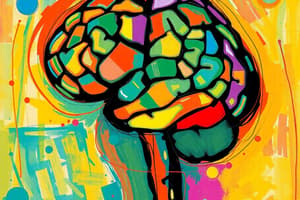Podcast
Questions and Answers
What is the primary function of the basal ganglia in motor control?
What is the primary function of the basal ganglia in motor control?
- To regulate movement through direct modulation
- To control cognitive processes
- To initiate and suppress behavior (correct)
- To process sensory information
Which structure sends inhibitory projections to the external globus pallidus?
Which structure sends inhibitory projections to the external globus pallidus?
- Internal globus pallidus
- Striatum (correct)
- Subthalamic nucleus
- Thalamus
What is the role of the internal globus pallidus in the indirect pathway?
What is the role of the internal globus pallidus in the indirect pathway?
- Sends excitatory output to the cortex
- Sends inhibitory output to the subthalamic nucleus
- Sends inhibitory output to the thalamus (correct)
- Sends excitatory output to the thalamus
What is the effect of dopamine release from the substantia nigra on the indirect pathway?
What is the effect of dopamine release from the substantia nigra on the indirect pathway?
Which disease is associated with dysfunction of the indirect pathway?
Which disease is associated with dysfunction of the indirect pathway?
What is the final structure in the indirect pathway that projects back to the cortex?
What is the final structure in the indirect pathway that projects back to the cortex?
What is the role of the indirect pathway in normal movement and behavior?
What is the role of the indirect pathway in normal movement and behavior?
What is the result of dysregulation of the indirect pathway in Huntington's disease?
What is the result of dysregulation of the indirect pathway in Huntington's disease?
What is a characteristic of external globus pallidus neurons in HD mice?
What is a characteristic of external globus pallidus neurons in HD mice?
What is a potential therapeutic approach to manage HD symptoms?
What is a potential therapeutic approach to manage HD symptoms?
What is the basal ganglia indirect pathway?
What is the basal ganglia indirect pathway?
Why is the basal ganglia indirect pathway important in understanding movement disorders?
Why is the basal ganglia indirect pathway important in understanding movement disorders?
Flashcards are hidden until you start studying
Study Notes
Basal Ganglia Indirect Pathway
The basal ganglia are a series of subcortical nuclei that play a crucial role in motor control and behavior. The basal ganglia are involved in the initiation or suppression of behavior and can regulate movement through modulating the direct and indirect pathways. The indirect pathway, in particular, is a complex circuit that plays a significant role in the development of movement disorders such as Huntington's disease (HD).
Structure of the Basal Ganglia Indirect Pathway
The indirect pathway consists of a series of interconnected nuclei within the basal ganglia, including the striatum, the external globus pallidus (GPe), the subthalamic nucleus (STN), the internal globus pallidus (GPi), and the thalamus. The indirect pathway has opposing actions when activated by cortical neurons and is modulated by dopamine release from the substantia nigra into the striatum.
- Striatum: The striatum, which consists of the caudate nucleus and the putamen, sends inhibitory projections to the external segment of the globus pallidus (GPe).
- External Globus Pallidus (GPe): GABA-ergic neurons in GPe project to the subthalamic nucleus (STN), which then sends excitatory output to the internal segment of the globus pallidus (GPi).
- Internal Globus Pallidus (GPi): GPi sends inhibitory output to the thalamus.
- Thalamus: The thalamus projects back to the cortex.
Role in Movement Disorders
The indirect pathway is critical for normal volitional movement and behavior (Dodson et al., 2015; Tecuapetla et al., 2016; Pasquereau and Turner, 2017; Markowitz et al., 2018; Aristieta et al., 2020). Dysregulation of this pathway can contribute to motor dysfunction, as seen in Huntington's disease (Bates et al., 2015; Reiner and Deng, 2018). For example, in HD mice, hyperactivity of external globus pallidus neurons and excessive inhibition of their targets are key features of the disease (Bevan et al., 2022). This dysregulation could potentially be targeted by viral-based, gene therapeutic approaches to help manage HD symptoms (Bevan et al., 2022).
In summary, the basal ganglia indirect pathway is a complex circuit within the basal ganglia that plays a crucial role in normal motor control and behavior. Dysregulation of this pathway can contribute to movement disorders such as Huntington's disease, highlighting its importance in understanding and treating these conditions.
Studying That Suits You
Use AI to generate personalized quizzes and flashcards to suit your learning preferences.




